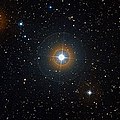sequence space has been explored by life on the Earth. Evolution by natural selection can be visualised as the process of sampling nearby sequences in...
13 KB (1,414 words) - 02:44, 16 December 2024
chemical space. Cheminformatics Drug design Sequence space (evolution) Molecule mining Reymond, J.-L.; Awale, M. (2012). "Exploring chemical space for drug...
8 KB (962 words) - 07:02, 12 December 2024
universe. Although the Xeelee are masters of space and time capable of influencing their own evolution, they are ultimately unsuccessful in stopping...
24 KB (1,879 words) - 01:24, 17 May 2025
landscape. During neutral evolution, genes can randomly move through neutral networks and traverse regions of sequence space which may have consequences...
24 KB (2,832 words) - 23:45, 17 October 2024
In astronomy, the main sequence is a classification of stars which appear on plots of stellar color versus brightness as a continuous and distinctive band...
61 KB (6,825 words) - 06:23, 3 May 2025
directed evolution is the generation of a library of variant genes. The sequence space for random sequence is vast (10130 possible sequences for a 100...
44 KB (4,761 words) - 04:28, 3 February 2024
stable state, beginning the main-sequence phase of its evolution. A new star will sit at a specific point on the main sequence of the Hertzsprung–Russell diagram...
50 KB (6,437 words) - 20:53, 17 May 2025
Euclidean vector spaces, examples of Hilbert spaces include spaces of square-integrable functions, spaces of sequences, Sobolev spaces consisting of generalized...
128 KB (17,469 words) - 04:45, 14 May 2025
A K-type main-sequence star, also referred to as a K-type dwarf, or orange dwarf, is a main-sequence (hydrogen-burning) star of spectral type K and luminosity...
13 KB (1,425 words) - 20:20, 10 March 2025
Red dwarf (redirect from M-type main sequence)
A red dwarf is the smallest kind of star on the main sequence. Red dwarfs are by far the most common type of fusing star in the Milky Way, at least in...
36 KB (4,265 words) - 18:28, 17 May 2025
CRISPR (category Repetitive DNA sequences)
"Intervening sequences of regularly spaced prokaryotic repeats derive from foreign genetic elements". Journal of Molecular Evolution. 60 (2): 174–182...
123 KB (13,281 words) - 19:36, 12 May 2025
Multiple sequence alignment (MSA) is the process or the result of sequence alignment of three or more biological sequences, generally protein, DNA, or...
49 KB (6,213 words) - 12:51, 15 September 2024
Star (section Main sequence)
sequence turnoff in the cluster to which they belong; in standard stellar evolution, blue stragglers would already have evolved off the main sequence...
148 KB (16,418 words) - 01:39, 18 May 2025
"Intragenomic Variation and Evolution of the Internal Transcribed Spacer of the rRNA Operon in Bacteria". Journal of Molecular Evolution. 65 (1): 44–67. Bibcode:2007JMolE...
20 KB (2,215 words) - 14:36, 28 March 2025
relationships." Understanding Evolution, Glossary of Terms The Oxford English Dictionary defines biological lineage as "a sequence of species each of which...
6 KB (761 words) - 15:01, 19 February 2025
Protostar (section Protostellar evolution)
(2022). Stellar birthline Pre-main-sequence star Protoplanetary disk Quasi-star Star formation Stellar evolution Stahler, S. W. & Palla, F. (2004). The...
10 KB (1,217 words) - 10:54, 5 April 2025
long sequences are accompanied only by music. Shunning the convention that major film productions should feature original music, 2001: A Space Odyssey...
181 KB (18,894 words) - 20:41, 6 May 2025
543H. doi:10.1046/j.1365-8711.2000.03426.x. S2CID 18523597. "Evolution from the Main Sequence to Red Giants | Astronomy". courses.lumenlearning.com. Retrieved...
12 KB (1,170 words) - 14:37, 20 March 2025
interstellar space. Stellar astronomy – concerned with Star formation, physical properties, main sequence life span, variability, stellar evolution and extinction...
11 KB (1,168 words) - 20:28, 17 May 2024
Bayesian, and minimum evolution are typical optimality criteria used to assess how well a phylogenetic tree topology describes the sequence data. Nearest Neighbour...
65 KB (8,217 words) - 01:14, 29 April 2025
evolution and genetic diversity of sequences and organisms Identification of molecular structure from sequence alone. Since the very first sequences of...
33 KB (3,894 words) - 07:15, 23 July 2024
the development of theories of molecular evolution. Margaret Dayhoff's 1966 comparison of ferredoxin sequences showed that natural selection would act...
48 KB (5,004 words) - 01:01, 29 April 2025
framework allowing understanding of the evolution of the Earth's surface in a particular region through time. Sequence stratigraphy is a useful alternative...
20 KB (2,621 words) - 18:24, 19 December 2024
onto a conveyor belt, where the observer can observe the sequence of the balls but not the sequence of urns from which they were drawn. The genie has some...
52 KB (6,811 words) - 04:08, 22 December 2024
Schwefel and their co-workers. Evolution strategies use natural problem-dependent representations, so problem space and search space are identical. In common...
20 KB (2,053 words) - 04:39, 15 April 2025
infant stars of less than 3 solar masses (M☉) in the pre-main-sequence phase of stellar evolution. It ends when a star of 0.5 M☉ or larger develops a radiative...
8 KB (901 words) - 02:38, 21 March 2025
Evidence of common descent (redirect from Argument from evolution)
evolution of complex sequences, such as proteins." Evolutionary molecular engineering, also called directed evolution or in vitro molecular evolution...
245 KB (27,677 words) - 20:52, 3 May 2025
moving through a search space. For example, the search space of a gene would be all possible nucleotide sequences. The search space is only part of an evolutionary...
22 KB (2,716 words) - 17:52, 11 March 2024
Sequence saturation mutagenesis (SeSaM) is a chemo-enzymatic random mutagenesis method applied for the directed evolution of proteins and enzymes.[citation...
12 KB (1,441 words) - 00:26, 24 November 2022
(March 2007). "Whole-mtDNA Genome Sequence Analysis of Ancient African Lineages". Molecular Biology and Evolution. 24 (3): 757–768. doi:10.1093/molbev/msl209...
264 KB (26,349 words) - 18:32, 5 May 2025


















